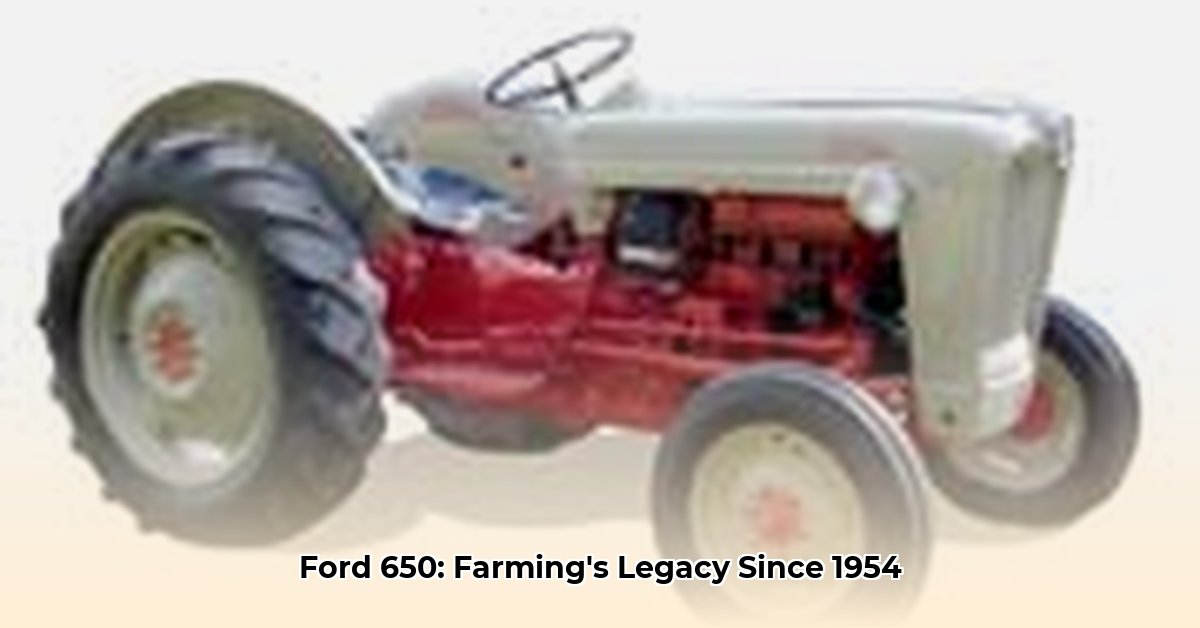
The Ford 650: A Case Study in Agricultural Mechanization and Sustainability
The Ford 650 tractor, introduced in 1954, represents a pivotal moment in agricultural mechanization. Its impact extends beyond increased productivity, offering a valuable lens through which to examine the evolving relationship between agricultural technology and sustainable farming practices. This article analyzes the Ford 650's design, operational characteristics, and long-term consequences, comparing it to modern tractors to assess its contribution to – and challenges for – sustainable agriculture. How did this workhorse of the mid-20th century shape the agricultural landscape, and what lessons can we glean from its legacy? For more detailed specifications, check out this Ford 650 data.
Fuel Efficiency: A Historical Perspective
The Ford 650, while revolutionary for its time, was significantly less fuel-efficient than modern tractors. This higher fuel consumption translated directly into increased greenhouse gas emissions. While environmental considerations were less prominent in the 1950s, this factor is paramount in contemporary discussions of sustainable agriculture. The increased fuel costs alone, when compared to the operating expenses of present-day tractors, present a clear economic argument against using such older models for large-scale farming in today's environment. Is the historical significance of the 650 enough to outweigh its impact on modern sustainability goals?
Soil Compaction: A Legacy of Impact
The relatively heavy weight of the Ford 650, compared to modern designs, contributed to soil compaction. This compaction reduces water infiltration, impacting crop yields and overall soil health. This unintended consequence highlights the importance of considering the long-term effects of agricultural technology on soil ecosystems. Modern research continues to investigate the long-term impacts of soil compaction, emphasizing the need for practices that minimize soil disturbance and maintain soil health. What innovative solutions are currently in place to mitigate these historical problems of compaction through technological and procedural adaptations in modern farming?
The Three-Point Hitch: A Lasting Contribution
Despite its drawbacks, the Ford 650's adoption of the three-point hitch system was a significant technological advance. This system's versatility allowed for the easy attachment and detachment of various implements, increasing the tractor's functionality and efficiency. This adaptability was a crucial factor in the subsequent development of more specialized and efficient farming tools, contributing indirectly to more sustainable agricultural practices over time. The inherent adaptability of the three-point hitch remains a critical design element in modern agricultural machinery, highlighting the enduring value of this innovation.
Comparing Tractors: Then and Now
A direct comparison between the Ford 650 and modern tractors underscores the advancements in sustainable agricultural technology. Modern tractors boast significantly improved fuel efficiency, reduced emissions, and lighter designs minimizing soil compaction. These improvements reflect a growing awareness of environmental concerns and the integration of innovative technologies. However, this comparison also highlights the trade-offs often involved in striving for increased productivity. How do these improvements balance with the overall economic and environmental costs of newer, more specialized machinery?
Assessing Sustainability in Older Farm Equipment
The Ford 650's longevity raises crucial questions regarding the sustainability of older farm equipment. Deciding whether to utilize such equipment involves a careful assessment of multiple factors:
- Mechanical Integrity: A comprehensive inspection is essential to determine the extent of necessary repairs and their financial implications.
- Operational Efficiency: Evaluating fuel consumption and comparing operational costs against modern equivalents is vital.
- Parts Availability: Securing replacement parts for older machinery can be challenging and impacts long-term viability.
- Environmental Impact: While possessing a lower initial carbon footprint than modern tractors, operational emissions must be considered.
- Cost-Benefit Analysis: A thorough cost-benefit analysis is paramount; comparing total ownership costs to the expense of a modern tractor is essential.
Conclusion: Lessons from the Past, Shaping a Sustainable Future
The Ford 650 serves as a powerful case study highlighting the evolution of agricultural technology and the importance of considering long-term sustainability. Although it possessed limitations regarding fuel efficiency and soil compaction, its contribution to the development of versatile farming implements is undeniable. By acknowledging both the achievements and shortcomings of this historical workhorse, we can continue to strive for a future where agricultural productivity and environmental responsibility coexist harmoniously. The ongoing quest for sustainable agricultural practices demands continuous innovation and research, building upon the lessons learned from the past.